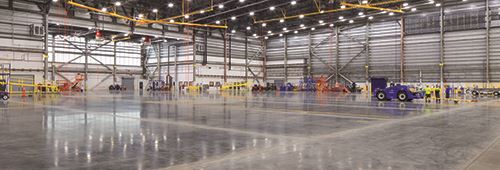In aviation and architecture, the horizon is ever distant. At Denver International Airport (DEN), sightlines are clear, and the future looks bright. Southwest Airlines’ new hangar, which opened on the eastern edge of the airfield in March 2022, represents a $100 million investment of permanence.
In aviation and architecture, the horizon is ever distant. At Denver International Airport (DEN), sightlines are clear, and the future looks bright. Presently the third-busiest airport in the United States, DEN is growing on many fronts. Its recently completed Concourse Expansion Program added 39 new gates during a multi-year project that overhauled the airport’s footprint. Meanwhile, the ongoing $1.3 billion Great Hall improvement project that kicked off in 2022 is expected to continue into summer 2028. Among it all, Southwest Airlines’ new hangar, which opened on the eastern edge of the airfield in March 2022, represents a $100 million investment of permanence.
 “DEN takes a lot of pride in our partnerships with Colorado communities and the airlines that we serve,” says George Karayiannakis, senior vice president for Airline and Commercial Affairs. As the main economic driver for Colorado’s Front Range, DEN injects an estimated $33 billion annually into local economies, and fully 60% of its passengers are on origination and destination flights. Since opening in 1995, DEN has grown from 33.1 million annual passengers to a
“DEN takes a lot of pride in our partnerships with Colorado communities and the airlines that we serve,” says George Karayiannakis, senior vice president for Airline and Commercial Affairs. As the main economic driver for Colorado’s Front Range, DEN injects an estimated $33 billion annually into local economies, and fully 60% of its passengers are on origination and destination flights. Since opening in 1995, DEN has grown from 33.1 million annual passengers to a
pre-pandemic high of 69 million. And airport leaders have their sights set even higher with Vision 100, an initiative to grow annual enplanements to 100 million passengers in
the next eight to 10 years.
“We are delighted that Southwest chose DEN as the site for its new hangar,” says Karayiannakis. “Southwest announced this project in 2019. They made a tremendous investment and showed incredible fortitude to keep working through COVID.”
|
facts&figures Project: Aircraft Maintenance Hangar Location: Denver Int’l Airport Hangar Owner: Southwest Airlines Purpose: Overnight repairs Size: 128,000 sq. ft. Capacity: Three 737s inside, 8 more outside Designer: Ghafari Associates Builder: Swinerton Builders Program Manager: Jviation Facility Feature: 6 prefabricated fiberglass service pits Hangar Doors: Megadoor, by ASSA ABLOY Entrance Systems Construction: July 2019-March 2022 |
Building Big
Designed to house three 737 airplanes and park eight more on the apron, the 128,000-square-foot hangar is the first of its kind to open at DEN. The heavy steel and structural concrete building features a 207-foot clear span that is nearly the length of a football field, and required 48,000 cubic yards of concrete to construct. Airport leaders attribute its reduced carbon footprint to creative problem solving by the project team. The large, specialized facility is also a template for other similarly sized hangars the airline is currently planning at strategic locations throughout the U.S.
“DEN is a key cog for Southwest,” says Jay Fretwell, Sr., the airline’s manager of Facilities Projects. Fretwell oversees a team of nine project managers who lead construction projects for the 121 U.S. airports that Southwest serves. His team develops plans with designers and builders for everything from mega-assets such as hangars to small back offices and ticket counters. When developing the recent project at DEN, Southwest worked with designers from Ghafari Associates to address the facility’s inherent need to accommodate larger, more complex aircraft. “We expect this hangar to be in operation for the next 50 years,” says Fretwell. “It was designed and built for airplanes that don’t even exist today.”
For starters, the supersized facility required a supersized door. Technically five doors in one, the Megadoor stretches the length of the building with a tail pocket in the middle. The five fabric doors can fold up in sections, either individually, in groups, or all together. Above, the hangar’s central overhead structural member is a box truss that stretches the full 270 feet of the hangar and weighs 180,000 pounds. The truss was so large, it required special pre-installation planning by the building team from Swinerton Builders. Due to FAA regulations limiting crane heights next to taxiways, Swinerton led an extensive search to find the right combination of low boom height and high strength. In a single day, a 500-ton Hydra crane and a 300-ton conventional crane swung the truss into place and held it there until workers secured it with bolts and welds. Due to the extreme length and loading, Swinerton used 3-D laser scans of the truss on the ground, after it was in place, and after it was roof-loaded to validate that the camber remained within tolerance.
Like other facilities at DEN, Southwest’s new maintenance hangar was developed with the environment in mind. As construction was getting underway, builders took note of the airport’s waste concrete storage yard just across a fence from the jobsite. Working with Southwest and DEN, Swinerton brought in a crusher and recycled the existing concrete to use as subgrade fill. This saved a tremendous amount of time and money that would have been spent acquiring, hauling and handling such material. It also significantly reduced the building’s embodied carbon count.
Nationwide Network
“Future-proofing” facilities has been a frequent topic of conversation for the seven years Fretwell has been with the airline. It’s part of the Southwest way, he adds.
“The DEN hangar was designed so that an entire wall is ready to remove and expand whenever that time comes,” says Fretwell.
Although it is the newest hangar Southwest has brought online, it’s not the only one. Fretwell and his team focus on a nationwide facilities masterplan every day. The hangar at DEN comes on the heels of a larger hangar at Houston Intercontinental (IAH) that opened in January 2020 and serves as the overall hangar template. Southwest has already hired a contractor to build a near duplicate of the DEN hangar at Baltimore/Washington International Thurgood Marshall Airport (BWI). The airline is currently working on a project to expand its existing hangar at Phoenix Sky Harbor International Airport (PHX), and is looking to potentially add similar facilities at other airports where the airline has large operations.
 “Prior to Houston, Southwest hadn’t built a hangar in 20 years,” Fretwell reflects. “At the time, a lot of our existing hangars were designed for smaller aircraft. Some showed their age in both technology and wear and tear. We embarked on a facility master planning process that began with a flagship facility in Houston and has evolved through a series of iterations that combine prototype thinking, site-adapted solutions and lessons learned as we go.”
“Prior to Houston, Southwest hadn’t built a hangar in 20 years,” Fretwell reflects. “At the time, a lot of our existing hangars were designed for smaller aircraft. Some showed their age in both technology and wear and tear. We embarked on a facility master planning process that began with a flagship facility in Houston and has evolved through a series of iterations that combine prototype thinking, site-adapted solutions and lessons learned as we go.”
The flagship facility at IAH is a two-bay, six-aircraft hangar, which is twice the size of the airline’s maintenance facilities at DEN. The team at DEN used the project at IAH as a template. In particular, Swinerton studied the high-tech aircraft service pits within the hangar floor. At two stations per aircraft, each of the six prefabricated fiberglass units includes the equipment and tools technicians need to power and maintain an airplane parked above. The pits are recessed roughly 12 feet into the hangar floor, which slopes ½% for drainage; and the lips around the pits must be dead-to-nuts even when contractors pour the concrete.
Pandemic Twists
Construction at DEN was originally planned to begin in July 2019 and last 17 to 19 months. Eight months into construction, however, COVID changed everything. In addition to requiring daily temperature checks, hand washing stations, social distancing and heightened sanitization practices, the global pandemic prompted Southwest to slow construction of its hangar project. As passenger demand plummeted to historic lows, the airline was forced to shift budgets to support its overall operations—including slowing or pausing capital expenditures. As a result, Swinerton needed to quickly adjust to the budget changes and completely re-sequence the subcontractor schedules.
“With COVID, there were many opportunities for this project to derail,” Fretwell remarks. “Thanks to the incredible support, investment and tenacity of Swinerton and Ghafari, and the Program Management team at Jviation we brought this in on budget—a phenomenal feat.”

More on the Horizon
Building on lessons learned and experience earned, the next maintenance hangar for Fretwell’s team will be at BWI.
“With DEN, we developed a model that can be site-adapted for any facility. BWI’s hangar will be the first example of that,” says Fretwell. “For example, in Baltimore, the site is adjacent to an FAA NAVAID. So we had to cant the exterior 15 degrees on that side to help deflect radar to the ground. Inside the hangar, DEN and BWI are mirror images; but on the exterior, there are differences.”
Another point of difference on the BWI project is that the airport contracted an independent team to clear and develop the site pad to prepare it for the new hangar.
“We learned a tremendous amount designing and building the hangar at HOU. Then, we were immediately able to roll that into DEN, and now onto BWI in relatively short order,” Fretwell explains. “We have three buildings that will function similarly for our workforce, yet are wholly distinct for each location.
“For Southwest, safety is first and foremost,” he emphasizes. “To be able to invest in these modern hangars to provide proper protection is a key part of our overall business strategy. As Southwest grows, these hangars are critical to our long-term success.”



